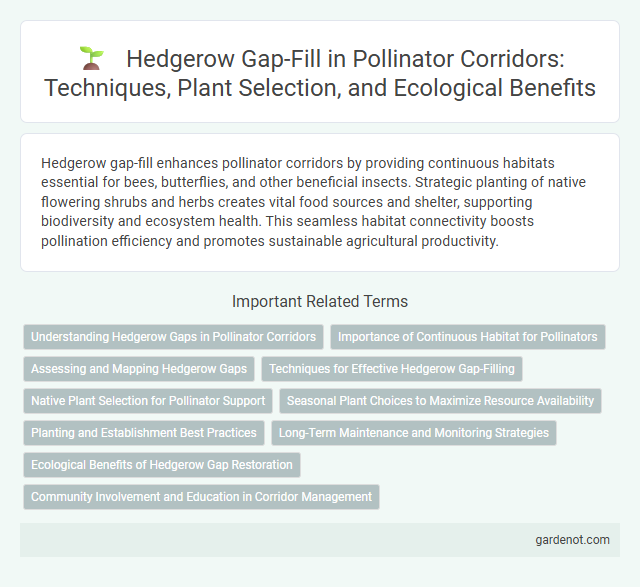Hedgerow gap-fill enhances pollinator corridors by providing continuous habitats essential for bees, butterflies, and other beneficial insects. Strategic planting of native flowering shrubs and herbs creates vital food sources and shelter, supporting biodiversity and ecosystem health. This seamless habitat connectivity boosts pollination efficiency and promotes sustainable agricultural productivity.
Understanding Hedgerow Gaps in Pollinator Corridors
Hedgerow gaps in pollinator corridors disrupt continuous habitats essential for foraging and movement of native pollinators such as bees and butterflies. Effective gap-fill strategies involve planting native flowering shrubs and wildflowers to restore connectivity and promote biodiversity resilience. Continuous hedgerows enhance pollination services critical for agricultural productivity and ecosystem health.
Importance of Continuous Habitat for Pollinators
Continuous habitat along pollinator corridors is essential for maintaining biodiversity and supporting pollinator populations. Hedgerow gap-fill enhances connectivity by providing safe passage and abundant floral resources, reducing habitat fragmentation that threatens pollinator foraging and nesting behaviors. Effective gap-fill strategies promote genetic diversity and improve ecosystem resilience by sustaining pollinator movement across agricultural and natural landscapes.
Assessing and Mapping Hedgerow Gaps
Assessing and mapping hedgerow gaps involves detailed field surveys combined with high-resolution satellite imagery to identify discontinuities in pollinator corridors. Geographic Information System (GIS) tools enable precise spatial analysis of hedgerow networks, highlighting critical gap areas that disrupt pollinator movement and biodiversity connectivity. Effective gap-fill interventions rely on this data-driven approach to restore habitat continuity and support pollinator populations.
Techniques for Effective Hedgerow Gap-Filling
Effective hedgerow gap-filling techniques involve planting native flowering shrubs and trees that provide continuous nectar and pollen sources for pollinators. Using a mix of species with staggered bloom times ensures sustained habitat connectivity and enhances biodiversity within the pollinator corridor. Incorporating layered planting, including ground cover, mid-story, and canopy species, improves structural diversity essential for various pollinator species.
Native Plant Selection for Pollinator Support
Selecting native plants for hedgerow gap-fill enhances pollinator corridors by providing essential nectar and pollen resources tailored to local pollinator species. Native plants support the life cycles of indigenous bees, butterflies, and other pollinators, promoting biodiversity and habitat connectivity. Optimal species choices include flowering shrubs, wildflowers, and grasses that bloom sequentially, ensuring continuous forage throughout the pollination season.
Seasonal Plant Choices to Maximize Resource Availability
Selecting diverse seasonal plants such as early-blooming crocuses, mid-spring wildflowers, and late-summer asters maximizes nectar and pollen availability throughout the pollination period. Incorporating native shrubs like hazel and hawthorn ensures continuous flower presence, providing essential habitat continuity for bees and butterflies. Strategically filling hedgerow gaps with multi-seasonal flora enhances pollinator corridor connectivity and supports biodiversity resilience.
Planting and Establishment Best Practices
Planting native wildflowers, shrubs, and trees in hedgerow gap-fill enhances pollinator habitat connectivity and biodiversity. Optimal establishment practices include selecting site-appropriate species, ensuring soil preparation with minimal disturbance, and implementing phased planting to support staged pollinator resource availability. Consistent monitoring and adaptive management promote healthy growth and sustained ecosystem services.
Long-Term Maintenance and Monitoring Strategies
Implementing long-term maintenance and monitoring strategies in hedgerow gap-fill projects ensures the sustainability of pollinator corridors by promoting continuous habitat connectivity. Regular assessments guide adaptive management practices such as selective pruning, invasive species control, and replanting native flora to support diverse pollinator populations. Data collected over time facilitates the evaluation of species richness and corridor effectiveness, enabling targeted interventions that enhance ecosystem resilience and biodiversity conservation.
Ecological Benefits of Hedgerow Gap Restoration
Hedgerow gap-fill restoration enhances biodiversity by providing continuous habitats for pollinators such as bees, butterflies, and other insects essential for ecosystem productivity. Restored hedgerows improve landscape connectivity, facilitating pollinator movement and gene flow between plant populations, which promotes resilient and diverse ecosystems. These corridors also support natural pest control and soil health, contributing to sustainable agricultural practices and overall ecological balance.
Community Involvement and Education in Corridor Management
Community involvement plays a vital role in hedgerow gap-fill within pollinator corridors by fostering local stewardship and enhancing biodiversity. Educational programs engage community members, raising awareness about native pollinators and the ecological benefits of continuous habitats. Collaborative efforts between conservation groups and schools facilitate monitoring and maintenance, ensuring long-term corridor connectivity and pollinator health.
Hedgerow gap-fill Infographic

 gardenot.com
gardenot.com